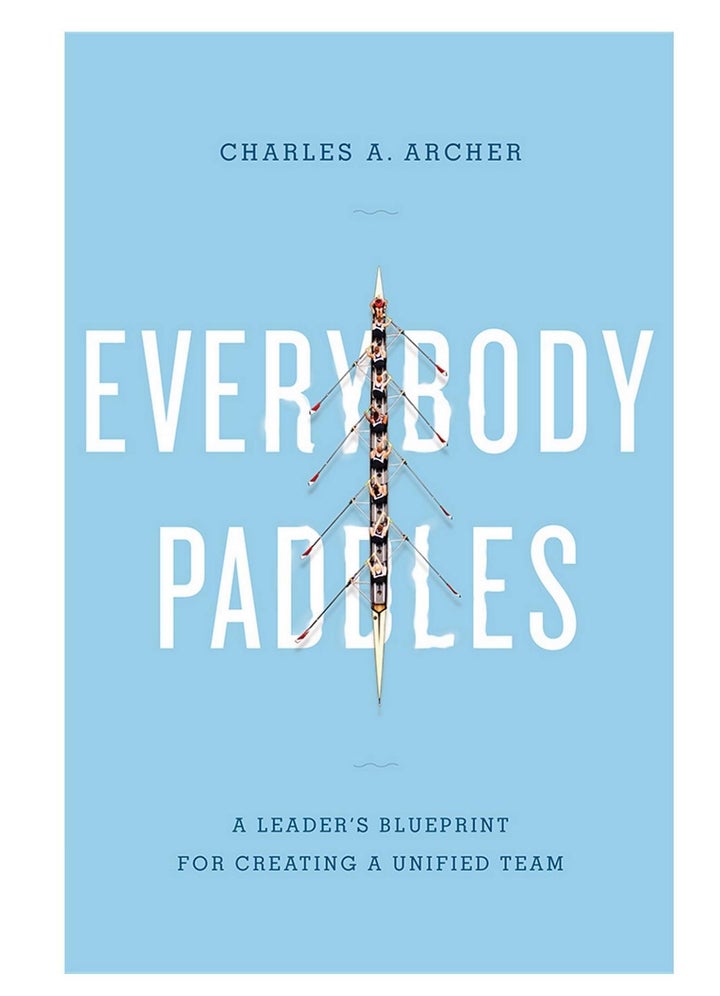
This is a book about team building and leadership. I had spent some time working on how to express these concepts in a clear, concise way when the solution came to me one day as I glanced at a magazine. I was attending a conference at the time, and at that point in the schedule we were supposed to be networking for the benefit not only of ourselves but also of our organizations. Somehow, the networking party just got out of hand. Things happen. So, I walked into a vacant room, sat down on a couch, and flipped through my phone messages. That’s when I saw it: a photograph of a whitewater raft on the cover of a sporting magazine.
There were five people in the raft as the river raged on, threatening to capsize them all. They were all leaning into their oars at the same moment, however, and were executing, as if in one complete, unified movement, a turn to avoid the face of a huge rock in front of them. The water parted in a V formation, splitting into two white jet streams, and all eyes were focused on the right-hand side. The intensity of their focus got to me, as well as the sense that they were all executing that one turns in total cooperation. No one was sloughing off—unlike the conventioneers at the raucous party outside. A life-or-death turn, executed perfectly, in unison, by five people.
“Everybody Paddles” became my slogan from then on. (There’s a saying in my office: “Charles is crazy. Don’t get in his way when he is passionate about something!”) This idea had captivated me.
A few days later I was back at the Evelyn Douglin Center for Serving People in Need (EDCSPIN), the nonprofit organization in Brooklyn I cofounded in 1996, where we handle about $25 million a year in services for the disabled community, and I imagined paddles everywhere—all over the walls—as a symbol of this newfound image of unity. I found a store that sold me a bunch of paddles, and the next day I started nailing them to the walls. To this day, they cover the premises. A few days after that, I took a magic marker and walked around our space—a large floor in an old custom building near the Brooklyn waterfront—and started writing on the paddles: “Everyone Paddles in the Same Direction, at the Same Time, Toward the Same Goal.”
I see this as a process that goes far beyond my social service agency. There’s no reason it can’t include individual families as well as communities, cities, states, and countries. That’s because Everybody Paddles represents a pattern of growth, development, and improvement that occurs when all participants work together for a common interest.
This concept is very important today. As we all know, society is divided by economics, education, classism, ageism, gender differences, religion, and partisan politics. Despite these challenges, I believe there is opportunity for unity because everyone shares the desired outcome of benefiting from a common interest.
It does take everyone working together to achieve a common goal. Yet I also recognize that we are individuals. As a result, the Everybody Paddles concept would seem to contradict the American mantra of self-dependence and individualism. It doesn’t. Let me explain why.
Great thinkers have often stressed individuality. I love a famous quotation from Hillel—one of the greatest sages in Jewish history—that encapsulates so much of what I want to say in this book: “If I am not for myself, who will be? If I am only for myself, what am I? If not now, when?”
With this perfect wording, uttered in first-century Jerusalem, Hillel was saying what I had been thinking all the while as the CEO of a social service agency: Stand up for yourself. Take responsibility and act as if you are alone during the crucial fights and moments. But also, always remember that human beings need one another, and “the other person is you.” When individuals with integrity join together with others of equal stature, they can paddle forward in confidence, trusting one another, to achieve what they set out to accomplish. Hillel introduced the concept of individuality, getting people to think about who they were. But according to historian Jacob Burchardt, it wasn’t until the Late Middle Ages—toward the beginning of the Renaissance, the time of rebirth of Western culture—that the concept truly began to catch on.
During the Middle Ages the veil covering human souls was a cloth of faith, biases, ignorance and illusions . . . in so far as the human being was considered only as belonging to a race, a population, a party, a corporation, a family or any other forms of “community.” For the first time, it was Italy that [broke] this veil and dictated the “objective” study of the State and other worldly things. This new way of considering reality aside, it further developed the “subjective” aspect, and man becomes “individual,” spiritual, assuming his new status’ consciousness.
America was founded soon after the end of the Renaissance in Europe by bold individuals who dared to sail thousands of miles across dangerous seas to an unknown land. As a result, Americans have always prided themselves on rugged individuality and acclaimed anyone with that perceived personality: mountain men and heroic soldiers Daniel Boone, Kit Carson, and Sergeant Alvin York come to mind.
The concept is stressed in our times. Donald Trump, a somewhat controversial businessman and developer who has helped many people lead productive lives, said about leadership, “You are a one-man army.” I agree. Yes, you are when you need to be.
The promotion of individuality, however, is only a façade. The web that unites us becomes clearly visible during tragedies, such as the terrorist attacks on September 11, 2001, or the Boston Marathon bombings on April 15, 2013. In both cases, communities around the country banded together to show their solidarity with the victims in each great city.
The same thing happened during the Iranian hostage crisis in the late 1970s, when yellow ribbons served as the symbol of American unity. Our individual opinions and political differences were smoothed over by the desire to present a united front as Americans. Americans may talk about “I” but are acutely aware that the better pronoun is “We.” We often work as individuals in a group setting. That approach provides opportunities for creativity while helping the organization reach toward its goal.
To promote this reality, I outline strategies that have been proven to modify attitudes, capabilities, and efforts, acknowledging that everybody within a given company must actively participate in the advancement of that company’s mission, vision, value structure, and deliverables.
To add practical experience to each principled approach, I have asked thought leaders and influencers to contribute their accounts of building consensus. These unique perspectives on the principles outlined in the book appear at the end of each chapter.
By the time you read this book, you will have a blueprint for building and maintaining company consensus. You will know how to make sure that everyone on your team is inside the boat, paddling with singular focus toward the desired destination. Get a copy Today:
Charles A. Archer, The THRIVE Network
